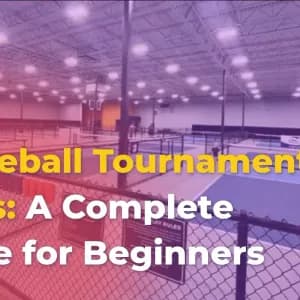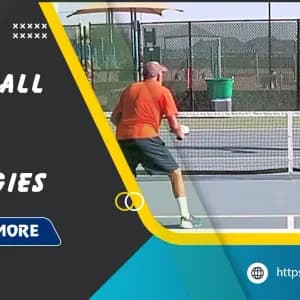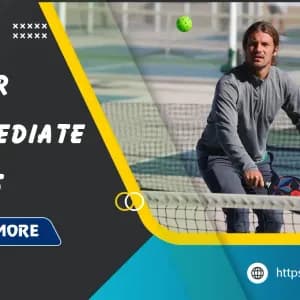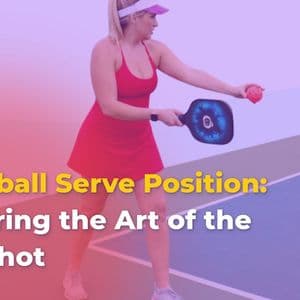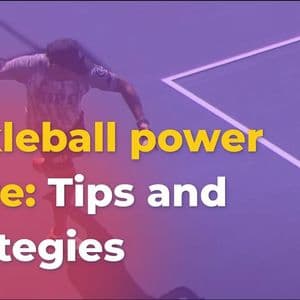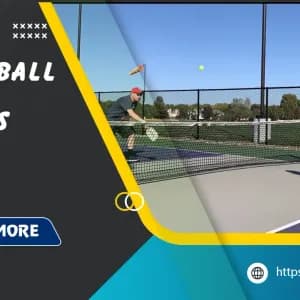Understanding the double hit
To properly address whether a double hit is permissible, we must first define what constitutes a double hit in pickleball. According to the USA Pickleball Official Rulebook, a double hit refers to an illegal action where a player strikes the ball twice in a single attempt to hit it. This doesn’t just occur through carelessness; it’s often the result of mishitting or misjudging the angle of the paddle. The essential rule here is that a player is allowed only one clean hit on the ball during any stroke.

Determining the legality of a double hit is nuanced but can generally be categorized into two separate aspects: accidental contact and continuous motion. For instance, if a player accidentally strikes the ball twice during a single sweeping motion without any intention of doing so, the hit may be deemed legal. However, intentional actions that lead to double hits, such as trapping the ball between the paddle and body or changing swing direction mid-hit, will undoubtedly be classified as faults.
The emphasis on skill development and fair play in pickleball is not just about avoiding penalties; it’s about refining technique and promoting a smooth rhythm in gameplay. By understanding these principles, players can navigate the complexities of double hits while enhancing their performance on the court.
Can you double hit in Pickleball: Legal or illegal
To grasp the delicate balance between legal and illegal double hits, it's beneficial to visualize each scenario.
In the realm of legal double hits, examples abound. Consider a player executing a forehand stroke with a continuous motion. If the ball contacts the paddle and deflects just prior to hitting the player’s body, which causes it to rebound back to the paddle without any deliberate intent to hit it again, this scenario illustrates a legal double hit. Videos showcasing this type of contact effectively capture the fluidity of movement while adhering to the established regulations.

In contrast, illegal double hits often arise from abrupt swings or unintentional alterations in paddle direction. For example, a player might attempt a quick volley but, in an effort to regain control, inadvertently change the swing direction mid-contact, resulting in multiple ball strikes. These types of incidents violate the double hit rule and will be called as faults by a referee or honest players in more casual contexts. Understanding these distinctions through videos and images can solidify a player’s comprehension and application of the rules during actual games.
Double hit vs. carrying: Clearing the confusion
While discussing double hits, it is also important to address the common confusion surrounding carrying. Both terms describe different types of ball contact but are often conflated, leading to misunderstandings among players.
Side-by-Side Comparison
| Aspect | Double Hit | Carrying |
|---|---|---|
| Definition | Striking the ball twice in one stroke | Holding or “carrying” the ball on the paddle |
| Intent | Unintentional contact | Typically intentional |
| Paddle Movement | Single fluid motion (if legal) | Extended pause in contact with the ball |
| Resulting Call | Fault if illegal double hit occurs | Fault if carrying is identified |
The pivotal distinction lies in the **paddle movement** and intent behind the action. A double hit generally results from the spontaneity of play an unexpected rebound while carrying is characterized by a pause in motion or an attempt to trap the ball, leading to a breach of regulations.
Understanding these differences allows players to self-monitor their hits more accurately, fostering better awareness during matches. Visuals that showcase these actions can provide further clarity and reinforce distinctions in play.
Impact of a double hit fault
The implications of an illegal double hit can significantly affect the flow of a game. When a double hit is called, the offending player faces the immediate consequences of a fault, often resulting in a point awarded to the opposing team. This can create a ripple effect, impacting both momentum and player morale.

For example, during a close match, if a player mistakenly executes a double hit, it may shift the game's momentum. The sudden loss of a point can deflate a team’s morale, while simultaneously boosting the confidence of their opponents. Real-world scenarios frequently reflect how critical each point becomes, especially during championship tournaments where every score can lead to victory or defeat.
Furthermore, illegal double hits often unfold in significant match moments, often leading to discussions among players about the fairness of the call and the circumstances surrounding it. Consequently, it’s vital for players to remain alert, ensuring they strike with precision to avoid these pitfalls and maintain the integrity of the match.
Player responsibility and etiquette
The essence of pickleball transcends just technique and strategy; it embodies sportsmanship and respect for the rules that govern play. One key aspect of this is the responsibility of players to self-call their own double hits. Particularly in casual games lacking formal referees, honesty becomes paramount.
Players should monitor their hits closely, acknowledging when a double hit occurs, regardless of the potential impact on their score. This commitment to fairness not only enhances the integrity of the game but also promotes camaraderie among participants. The spirit of pickleball encourages enjoyable, competitive pleasure it’s about having fun while adhering to rules.
Communication plays a pivotal role in enhancing collaboration during doubles play, where overlapping hits often result in double hit scenarios. Establishing clear expectations and calling out plays assists in minimizing confusion and built-up tension on the court. Developing effective communication methods, such as using agreed-upon cues, helps strengthen partnerships and elevates overall gameplay.
Mastering the art of avoiding double hits
As players become more aware of the nuances surrounding double hits, they can employ techniques and drills specifically aimed at avoiding them. Concentrating on ball control can be transformative, significantly reducing the likelihood of double hits.
Focus on grip techniques, paddle positioning, and the tactile feel of the paddle against the ball. Several drills, such as practicing with a partner or using wall rebounds, can sharpen these skills, enabling players to establish more reliable contact with the ball.
Example Drills:
- Paddle Touch Drill: Players lightly tap the ball against their paddle to enhance touch sensitivity.
- Wall Rebounds: Practicing returns against a wall for muscle memory and timing.
- Controlled Back-and-Forths: Partner practice focusing solely on consistent, clean hits.
Refining stroke mechanics will also contribute toward minimizing double hit incidents. Learning to execute various shots with a smooth, single motion whether they be volleys, groundstrokes, or dinks allows players to maintain a seamless rhythm during play. Establishing these mechanics through instruction or imagery helps solidify technique over time.
The importance of timing
Arguably, one of the most critical factors in avoiding double hits in pickleball is the concept of timing. Mastery over shot timing dramatically reduces the risk of mishits, allowing players to successfully anticipate the ball's trajectory and react accordingly.
Trained players can better gauge speed and angles, factoring in the opponent’s positioning. Practicing timing through dedicated drills, such as shadow swings and partner-target drills, allows for improvement in coordination and rhythm. The end goal is a smooth, uninterrupted stroke that connects perfectly without hesitation.
Timing Drills:
- Target Practice: Hitting specific spots on the court to hone precision and angles.
- Catch-Up Drills: Practicing hitting as the player moves to sharpen timing relative to ball approach.
Improving timing not only enhances personal performance but also contributes to a more enjoyable experience by reducing accidental faults, such as double hits.
Turning the tables: Advanced strategies
While maintaining fair play is paramount, advanced players might contemplate whether they can leverage legal double hits as a tactical advantage. It's crucial to note that any such attempts must meticulously adhere to the rules of the game to avoid penalties.
Experienced players may utilize spin, ball velocity, or directional manipulation through specific double hit techniques placing the ball into a tricky positioning against their opponents. Incorporating insights from esteemed professionals can provide fresh perspectives on legal double hits, highlighting specific plays, and opening up strategic gameplay avenues. However, it's essential to prioritize maintaining the spirit of the game and promoting fair competition.
In conclusion, while the double hit rule may appear black and white at first glance, the intricacies of its application add depth to one’s gameplay. Understanding the parameters surrounding double hits enables players to enhance their skills while promoting a fair and respectful environment on the court. Practicing diligently to improve ball control, refine stroke techniques, and master timing will not only minimize double hits but elevate overall performance in the vibrant world of pickleball.


